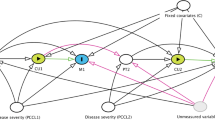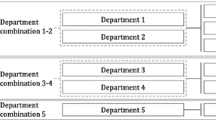Abstract
Hospital occupancy is a key metric in hospital-capacity planning in Germany, even though this metric neglects important drivers of economic efficiency, for example treatment costs and case mix. We suggest an alternative metric, which incorporates economic efficiency explicitly, and illustrate how this metric can be used in the hospital-capacity planning cycle. The practical setting of this study is the hospital capacity planning process in the German federal state of Rheinland-Pfalz. The planning process involves all 92 acute-care hospitals of this federal state. The study is based on standard hospital data, including annual costs, number of cases—disaggregated by medical departments and ICD codes, respectively—length-of-stay, certified beds, and occupancy rates. Using the developed metric, we identified 18 of the 92 hospitals as inefficient and targets for over-proportional capacity cuts. On the upside, we identified 15 efficient hospitals. The developed model and analysis has affected the federal state’s most recent medium term planning cycle.


Similar content being viewed by others
References
Conover, C.J., Sloan, F.A.: Does removing certificate-of-need regulations lead to a surge in health care spending? J. Health Polit. Policy Law 23, 455–481 (1998)
Federal Trade Commission and Department of Justice: Improving health care: a dose of competition. http://www.ftc.gov/reports/healthcare/040723healthcarerpt.pdf accessed on 4/8/2006 (2004)
Steen, J.: Certificate of need: a review. http://www.ahpanet.org/conarticles#con1 accessed on 4/8/2006 (1997)
Bruckenberger, E.: Wettbewerb und Planung. In: Arnold, M., Klauber, J., Schellschmidt, H. (eds.) Krankenhaus-report 2002, pp. 93–102. Schattauer, Stuttgart (2003)
Lungen, M., Lapsley, I.: The reform of hospital financing in Germany: an international solution? J. Health Organ. Manage. 17, 360–372 (2003)
Roeder, N., Rochell, B., Hindle, D.: Per case payment in Germany: all in a mess. Aust. Health Rev. 25, 223–238 (2002)
Altenstetter, C., Busse, R.: Health care reform in Germany: patchwork change within established Governance structures. J. Health Polit. Policy Law 30, 121–142 (2005)
Deily, M.E., McKay, N.L., Dorner, F.H.: Exit and inefficiency. J. Hum. Res. 35, 734–747 (2000)
Lindrooth, R.C., Lo Sasso, A.T., Bazzoli, G.J.: The effect of urban hospital closure on markets. J. Health Econ. 22, 691–712 (2003)
Bogetoft, P.: DEA and activity planning under asymmetric information. J. Productiv. Anal. 13, 7–48 (2000)
Depenheuer, O.: Staatliche Finanzierung und Planung im Krankenhauswesen. Duncker & Humblot, Berlin (1986)
Gaynor, M., Anderson, G.F.: Uncertain demand structure of hospital costs, and the cost of empty hospital beds. J. Health Econ. 14, 291–317 (1995)
Keeler, T.E., Ying, J.S.: Hospital costs and excess capacity: a statistical analysis. Rev. Econ. Stat. 78, 470–481 (1996)
Green, L.V., Nguyen, V.: Strategies for cutting hospital beds: the impact on patient service. Health Serv. Res. 36, 421–442 (2001)
Boardman, A.E., Greenberg, D.H., Vining, A.R., Weimer, D.L.: Cost-benefit analysis: concepts and practice. Prentice Hall, Upper Saddle River (2001)
Kuntz, L., Scholtes, S.: Measuring the robustness of empirical efficiency valuations. Manage. Sci. 46, 807–823 (2000)
Scheel, H.H.: EMS: efficiency measurement system. http://www.wiso.uni-dortmund.de/lsfg/or/scheel/ems (4/8/2006) (2006)
Worthington, A.C.: Frontier efficiency measurement in health care: a review of empirical techniques and selected applications. Med. Care Res. Rev. 61, 135–170 (2004)
Cooper, W.W., Seiford, L.M., Tone, K.: Data envelopment analysis. Kluwer, Boston (1999)
http://www.masfg.rlp.de/Gesundheit/Krankenhauswesen/Krankenhausplanung.htm accessed on 4/8/2006 (2006)
Olesen, O.B., Peterson, N.C.: The use of data envelopment analysis with probabilistic assurance regions for measuring hospital efficiency. J. Productiv. Anal. 17, 83–109 (2002)
Foit, K.: Marktorientierte Steuerung im Krankenhaussektor. Kölner Wissenschaftsverlag, Köln (2006)
Robra, B., Deh, U., Swart, E., Felder, S., Dralle, R.: Krankenhausplanung auf der Grundlage von, D.R.Gs. In: Klauber, J., Robra, B., Schellschmidt, H. (eds.) Krankenhaus-report 2003, pp. 137–147. Schattauer, Stuttgart (2004)
Gress, S., Jacobs, K., Schulze, S., Wasem, J.: Vertragswettbewerb und die Versorgung mit stationären Leistungen. In: Klauber, J., Robra, B., Schellschmidt, H. (eds.) Krankenhaus-report 2003, pp. 121–136. Schattauer, Stuttgart (2004)
Author information
Authors and Affiliations
Corresponding author
Appendices
Appendix A: mathematical model
We consider 92 hospitals. The number of patients treated in each hospital i differentiated by ICD codes (Model 1) and by specialist medical departments (Model 2) is given by the output variables Y i1,...,Y i21. The number of beds and the treatment costs are given by the input variables X i1 and X i2. With the help of p 1,...,p 21 and q 1, q 2, the weights for the outputs and inputs, respectively, we define for each hospital i the global output as Y i = p 1 Y i1 + ... + p 21 Y i21 and the global input as X i = q 1 X i1 + q 2 X i2. Let E i = Y i /X i be the output per unit of input; the efficiency score of each hospital i can then be calculated by use of the equation:
In the context of DEA it is the responsibility of each hospital manager to find the weights p 1,..., p 21 and q 1, q 2, which maximize the efficiency of the own hospital. This is a so-called quotient-optimization problem. This problem can be transformed into the following simple linear optimization problem:
with the constraints:
To avoid hospitals with very low capacity utilization becoming efficient by setting the weight of the capacity input to zero, we add the constraint q 1 ≥ 2,000q 2. This takes the more strategic dimension of this input into account. The constraint itself is based on the average cash flow per year and bed over the past 30 years funded by the German federal state Rheinland-Pfalz.
In the second step of our method the hospitals identified as inefficient in the first step are re-assessed. Because the inefficiency of the hospitals depends on the number of beds of the other hospitals, we would like to know how many beds must be passed on from an inefficient hospital to efficient hospitals so it becomes efficient. In particular, we would like to identify the hospitals which should receive beds from inefficient hospitals, that is, which should be used to build up capacity. Again, this problem can be transformed into a linear optimization problem. Let E be the set of indices of the inefficient hospitals and let λ e be the build-up of capacity in hospital e, e ∈E. Then the following linear optimization problem must be solved:
with the constraints:
Let λ * ie be the solutions of the linear optimization problem for hospital i. Then the build-up of capacity for each efficient hospital e was calculated by \({{\mathop {\max}\limits_{i \notin E}}\lambda ^{*}_{{ie}}.}\)
Appendix B
Table 4
Rights and permissions
About this article
Cite this article
Kuntz, L., Scholtes, S. & Vera, A. Incorporating efficiency in hospital-capacity planning in Germany. Eur J Health Econ 8, 213–223 (2007). https://doi.org/10.1007/s10198-006-0021-6
Received:
Accepted:
Published:
Issue Date:
DOI: https://doi.org/10.1007/s10198-006-0021-6




